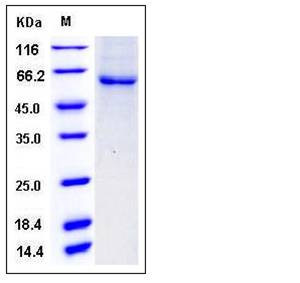Human GRK5 / GPRK5 Protein (His Tag)
GPRK5
- 100ug (NPP3910) Please inquiry
| Catalog Number | P10839-H08B |
|---|---|
| Organism Species | Human |
| Host | Baculovirus-Insect Cells |
| Synonyms | GPRK5 |
| Molecular Weight | The recombinant human GRK5 consists of 600 amino acids and predicts a molecular mass of 69 kDa. The apparent molecular mass of rhGRK5 is approximately 58 kDa in SDS-PAGE under reducing conditions. |
| predicted N | Met 1 |
| SDS-PAGE |  |
| Purity | > 90 % as determined by SDS-PAGE |
| Protein Construction | A DNA sequence encoding the human GRK5 (NP_005299.1) (Met 1-Ser 590) was fused with a polyhistidine tag at the C-terminus. |
| Bio-activity | No Kinase Activity |
| Research Area | Immunology |Signal Transduction |Akt Pathway |Intracellular Kinases in the Akt Pathway |
| Formulation | Lyophilized from sterile 50mM Tris, 100mM NaCl, 0.5mM PMSF, 1mM DTT, 0.5mM EDTA, 10% gly, pH 7.4 1. Normally 5 % - 8 % trehalose, mannitol and 0.01% Tween80 are added as protectants before lyophilization. Specific concentrations are included in the hardcopy of COA. |
| Background | G protein-coupled receptor kinase 5, also known as G protein-coupled receptor kinase GRK5 and GRK5, is a member of the protein kinase superfamily, AGC Ser/Thr protein kinase family and GPRK subfamily. GRKs specifically phosphorylate agonist-occupied G protein-coupled receptors at the inner surface of the plasma membrane (PM), leading to receptor desensitization. GRKs utilize a variety of mechanisms to bind tightly, and sometimes reversibly, to cellular membranes. GRKs play an important role in mediating agonist-specific desensitization of numerous G protein-coupled receptors. GRK5 contains one AGC-kinase C-terminal domain, one protein kinase domain and one RGS domain. GRK5 specifically phosphorylates the activated forms of G protein-coupled receptors. Phospholipid-stimulated autophosphorylation may represent a novel mechanism for membrane association and regulation of GRK5 activity. GRK5 deficiency significantly exaggerates microgliosis and astrogliosis in the presence of an inflammatory initiator, such as the excess fibrillar Abeta and the subsequent active inflammatory reactions. GRK5 deficiency has been linked to early Alzheimer's disease in humans and mouse models of the disease. |
| Reference |
